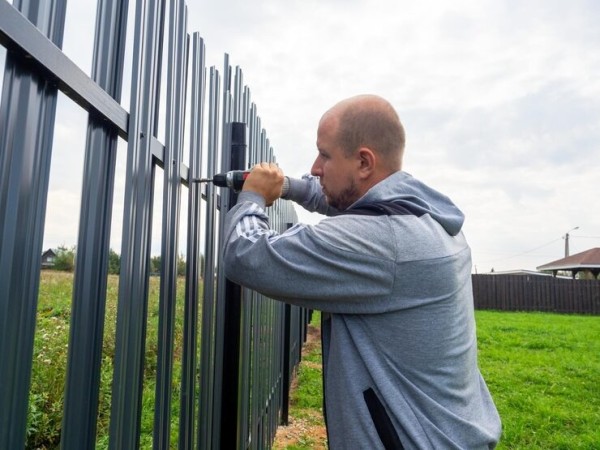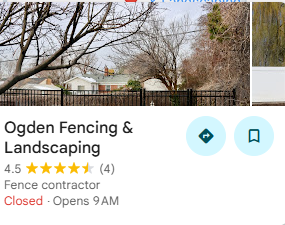Fence Installation Tips Every Homeowner Should Know Now
Installing a fence is one of the most effective ways to improve your home’s privacy, security, and curb appeal, but success depends on proper planning and execution. Homeowners should begin by assessing property lines, checking local regulations, and selecting durable materials suited to their climate and needs. Avoiding common mistakes—such as poor measurements or unstable post placement—ensures a long-lasting, attractive result.

Ogden, UT, United States, 28th Oct 2025 – Installing a fence might seem like a simple task, but there’s more to it than meets the eye. From choosing the right materials to understanding local regulations, every decision can impact the look, durability, and functionality of your property boundary. A well-installed fence not only enhances curb appeal but also provides security, privacy, and value to your home. Homeowners who approach fence installation with the right knowledge often save time, avoid costly mistakes, and enjoy a finished product that lasts for years.
In this guide, we’ll cover essential fence installation tips every homeowner should know. Whether you’re planning a DIY project or hiring professionals, these insights will help you make informed choices, streamline the process, and achieve a fence that perfectly complements your home and lifestyle.
Essential Tips for Planning Your Fence Installation Project
Planning is the most critical step in any fence installation project. Before picking materials or hiring contractors, homeowners need to assess their property layout, measure boundaries, and understand zoning restrictions. Proper planning ensures the fence fits the space perfectly and avoids legal issues. Knowing the purpose of your fence—whether for privacy, security, or decoration—will guide your choices in style and material. Investing time up front saves headaches and unnecessary costs later, making the process smoother and more efficient.
Once you’ve planned the layout, researching materials becomes easier. Each material has unique advantages and maintenance requirements. Wood offers a classic look but requires upkeep, while vinyl and metal provide durability with minimal maintenance. Choosing the right material, height, and style ensures your fence installation complements your home’s aesthetic and functions effectively. Planning also allows you to set a realistic budget and timeline, giving you confidence in the process from start to finish.
Choosing the Right Materials for a Long-Lasting Fence Installation
Selecting the right materials is crucial for a fence installation that stands the test of time. Homeowners must consider climate, durability, maintenance, and style when choosing between wood, vinyl, metal, or composite fencing. Wood offers warmth and tradition but may be prone to rot or warping in damp conditions. Vinyl is low maintenance and weather-resistant but can be less flexible in design. Metal fencing, including aluminum or wrought iron, provides strong security while adding an elegant touch. Understanding these material differences ensures your investment lasts and looks great for years.
Beyond material selection, it’s important to consider installation requirements. Some materials, like metal or vinyl, may need specialized tools or professional skills. Homeowners must also evaluate how the material suits their property’s slope, soil type, and local weather patterns. By carefully assessing these factors, you can choose a material that not only complements your home’s exterior but also minimizes future maintenance. Proper material selection is the foundation of a successful, long-lasting fence installation that enhances both appearance and functionality.
Avoiding Common Fence Installation Mistakes
Fence installation may seem simple, but small mistakes can lead to big problems. One common issue is failing to check property lines before digging. Installing a fence in the wrong location can cause disputes with neighbors and require costly adjustments. Another mistake is underestimating material needs or budget. Homeowners should carefully calculate lengths, posts, and gates to avoid interruptions or overages during installation. Neglecting local regulations, such as permits or height restrictions, can also create unnecessary delays or fines. Awareness and preparation prevent these common setbacks.
Attention to detail during installation is equally important. Posts must be set deep enough for stability, panels aligned correctly, and gates functional. Improperly installed fences can sag, shift, or fail under pressure. By learning from common errors, homeowners can achieve a strong, attractive fence that meets their needs and expectations. Planning, careful measurements, and adherence to guidelines ensure that your fence installation is a smooth, successful experience from start to finish.
Enhancing Property Value Through Smart Fence Installation
A well-installed fence does more than define boundaries—it can boost property value. Potential buyers often view a functional and attractive fence as a sign of a well-maintained home. Choosing durable materials and ensuring precise installation contributes to both curb appeal and long-term investment. A fence also offers practical benefits like privacy, security, and noise reduction, which are highly appealing in residential areas. Properly executed fence installation can therefore enhance the marketability and desirability of your property.
Strategic design choices also play a role in value enhancement. A fence that complements the home’s architecture and landscape creates a cohesive and appealing look. Homeowners should focus on materials, height, and style that harmonize with the surroundings. Beyond aesthetics, the fence should address functional needs such as safety for children or pets. By investing in quality installation and design, you can enjoy both immediate satisfaction and long-term property benefits, making your fence a valuable addition to your home.
Maximizing Privacy and Security with Proper Fence Installation
A fence can dramatically improve your home’s privacy and security when installed correctly. Choosing the right height, material, and style helps block unwanted views, reduce noise, and prevent intrusions. Solid wood or vinyl panels provide effective visual barriers, while metal or chain-link fencing can enhance security without sacrificing openness. Understanding your property’s vulnerabilities and designing the fence to address them ensures that your home feels safer and more comfortable for family members.
Installation technique also affects the fence’s effectiveness. Posts must be anchored securely, panels aligned without gaps, and gates fitted with sturdy locks. Neglecting these details can compromise both privacy and security. Homeowners should also consider landscaping and lighting around the fence to further deter intruders. By combining smart design choices with careful installation practices, your fence becomes a reliable tool for creating a secure, private, and peaceful home environment.
Budgeting Effectively for Your Fence Installation
Fence installation costs can vary widely depending on materials, length, labor, and additional features. Establishing a realistic budget before starting ensures you avoid financial surprises. Homeowners should research material costs, compare quotes from contractors, and factor in expenses like permits, post anchors, and gates. Setting a budget also helps prioritize design features, ensuring you get the best balance of quality, style, and affordability. Proper budgeting makes the fence installation process smoother and reduces stress.
It’s also wise to plan for maintenance costs over time. Wood fences may require staining or sealing, while metal fences could need rust prevention treatments. Vinyl and composite options often have minimal upkeep, but initial costs may be higher. Understanding both upfront and long-term expenses allows homeowners to make informed decisions and select materials that fit their financial plan. Thoughtful budgeting guarantees that your fence installation is both affordable and high-quality, providing lasting satisfaction.
Planning Your DIY Fence Installation Step by Step
DIY fence installation can be rewarding but requires careful preparation and knowledge. Start by measuring your property accurately, marking post locations, and checking for underground utilities. Selecting the right tools and materials ensures the project runs efficiently and safely. Homeowners should also review local codes or permits to avoid fines or complications. Proper planning and preparation are the foundation for a successful DIY fence installation.
During installation, follow a logical sequence to avoid errors. Set posts first for stability, then attach panels or rails, and finally install gates. Maintaining level lines and consistent spacing ensures both appearance and durability. Homeowners should also enlist help when handling heavy materials or long panels. By approaching DIY fence installation methodically, you can save money, enjoy a sense of accomplishment, and achieve a professional-looking result that enhances your property.
Landscaping Considerations When Installing a Fence
Fence installation affects more than just boundaries; it interacts with your entire landscape. Homeowners should consider plant placement, drainage, and lawn care before beginning. Installing a fence too close to trees or shrubs can create maintenance challenges, while proper spacing ensures healthy growth. Integrating your fence with existing landscaping elements enhances the overall appearance and makes maintenance easier. Planning around slopes, flower beds, and pathways guarantees a cohesive outdoor space.
Choosing fence style and height with landscaping in mind also adds visual appeal. Low fences may frame gardens elegantly, while tall fences provide privacy for backyard retreats. Consider how the fence complements your home’s exterior, walkways, and outdoor living spaces. Thoughtful landscaping planning ensures that fence installation enhances both function and aesthetics, creating a beautiful and practical environment around your property.
Hiring Professionals for Fence Installation
Some fence projects are best left to professionals. Hiring experienced contractors ensures proper installation, compliance with local codes, and a high-quality finish. Professionals bring expertise in material handling, post setting, and panel alignment, minimizing errors that can occur with DIY projects. They also provide valuable advice on design, materials, and maintenance, helping homeowners achieve the best results. Using skilled installers often saves time, effort, and potential repair costs down the road.
Before hiring, homeowners should request references, review past projects, and obtain detailed quotes. Clear communication about expectations, materials, and timelines helps prevent misunderstandings. Professionals also manage challenges like uneven terrain, drainage issues, or unusual property layouts efficiently. By choosing experienced installers, you ensure a durable, attractive, and functional fence that enhances your property and provides peace of mind for years to come.
Maintaining Your Fence After Installation
Fence installation is only the first step; proper maintenance keeps it looking great and performing well. Wooden fences benefit from regular sealing or staining to prevent rot, while metal fences may need rust protection or repainting. Vinyl and composite fences are lower maintenance but should still be cleaned periodically. Inspecting posts, panels, and gates for damage ensures your fence remains sturdy and reliable over time.
Preventive care also extends the lifespan of your fence. Remove debris or vegetation growing near the fence, adjust loose panels or gates promptly, and address any water drainage issues that could damage the base. A little attention now prevents costly repairs later and keeps your fence in top condition. Consistent maintenance protects your investment, preserves curb appeal, and ensures your fence continues to serve its purpose effectively for years after installation.
Conclusion
A well-planned fence installation can transform your property, enhancing both its beauty and functionality. Whether you need privacy, security, or simply a stylish boundary, taking the right steps ensures long-lasting results. From selecting the best materials to proper installation techniques, every detail matters in achieving a fence that complements your home and meets your needs. Thoughtful planning and execution provide peace of mind and protect your investment for years to come.
Ogden Fencing & Landscaping is ready to help you bring your vision to life. Our experienced team provides professional guidance, quality materials, and expert installation tailored to your property. For reliable service and exceptional results, contact us today at (801) 758-2645. Let us handle the hard work while you enjoy a beautiful, durable fence that enhances your home’s value and curb appeal.

Full business name: Ogden Fencing & Landscaping
Business addressed: 190 W 33rd St 160 unit g, Ogden, UT 84401, United States
Contact : +18017582645
Website:https://www.ogdenfencing.com/
Company Details
Organization: Ogden Fencing & Landscaping
Contact Person: Ogden Fencing & Landscaping
Website: https://www.ogdenfencing.com/
Email: Send Email
Contact Number: +18017582645
Address: 190 W 33rd St 160 unit g, Ogden, UT 84401, United States
City: Ogden
State: UT
Country: United States
Release Id: 28102536186
